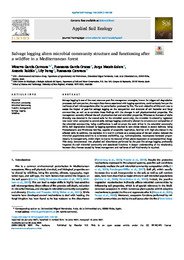Por favor, use este identificador para citar o enlazar este ítem:
https://hdl.handle.net/11000/33648Registro completo de metadatos
| Campo DC | Valor | Lengua/Idioma |
|---|---|---|
| dc.contributor.author | García-Carmona, Minerva | - |
| dc.contributor.author | Garcia-Orenes, Fuensanta | - |
| dc.contributor.author | Mataix Solera, Jorge | - |
| dc.contributor.author | Roldan, Antonio | - |
| dc.contributor.author | Pereg, Lily | - |
| dc.contributor.author | Ballester, Caravaca | - |
| dc.contributor.other | Departamentos de la UMH::Agroquímica y Medio Ambiente | es_ES |
| dc.date.accessioned | 2024-10-25T09:57:08Z | - |
| dc.date.available | 2024-10-25T09:57:08Z | - |
| dc.date.created | 2021-06-23 | - |
| dc.identifier.citation | Applied Soil Ecology. Volume 168, December 2021 | es_ES |
| dc.identifier.issn | 0929-1393 | - |
| dc.identifier.issn | 1873-0272 | - |
| dc.identifier.uri | https://hdl.handle.net/11000/33648 | - |
| dc.description.abstract | Salvage logging is one of the most common post-fire management strategies, known for trigger soil degradation processes. Soil compaction, the major disturbance associated with logging operations, could seriously hamper the resilience of soil microorganisms after the perturbation produced by fire. The main objective of this work was to assess the impact of post-fire salvage logging on the composition and structure of soil bacterial and fungi communities, as well as to correlate these findings with the changes in soil physicochemical properties. The management severely affected the soil physicochemical and microbial properties. Whereas an increase of alpha diversity was detected in the treated soils for the microbial community, the microbial functionality registered was lower when compared to control soils. Salvage logging profoundly altered the structure and composition of the microbial communities, being modifications in soil structure the main driver in the microbial community shifts. Soil degradation induced by logging operations resulted in new niches related to anoxic habitats, being Proteobacteria and Firmicutes families, capable of anaerobic respiration, families with high abundance in the affected soils. In addition, the depletion in C and N nutrients as a consequence of the soil erosion reduced the microbial populations sensitive to substrates availability, e.g. Actinomycetales. Ascomycota increased proportionally in managed soils, which might be due to the removal of host plants dependent on ectomycorrhizal fungi. This study demonstrated that physical soil disturbance performed by the post-fire salvage logging profoundly impacted the soil microbial community and associated functions. A deeper understanding of the relationship between disturbances caused by forest management and resilience of soil biodiversity is required | es_ES |
| dc.format | application/pdf | es_ES |
| dc.format.extent | 10 | es_ES |
| dc.language.iso | eng | es_ES |
| dc.publisher | Elsevier | es_ES |
| dc.rights | info:eu-repo/semantics/openAccess | es_ES |
| dc.rights | Attribution-NonCommercial-NoDerivatives 4.0 Internacional | * |
| dc.rights.uri | http://creativecommons.org/licenses/by-nc-nd/4.0/ | * |
| dc.subject | Microbial community | es_ES |
| dc.subject | Microbial functioning | es_ES |
| dc.subject | Post-fire management | es_ES |
| dc.subject | Salvage logging | es_ES |
| dc.subject | Wildfires | es_ES |
| dc.title | Salvage logging alters microbial community structure and functioning after a wildfire in a Mediterranean forest | es_ES |
| dc.type | info:eu-repo/semantics/article | es_ES |
| dc.relation.publisherversion | https://doi.org/10.1016/j.apsoil.2021.104130 | es_ES |

Ver/Abrir:
Salvage logging alters microbial commun...pdf
1,16 MB
Adobe PDF
Compartir:
 La licencia se describe como: Atribución-NonComercial-NoDerivada 4.0 Internacional.
La licencia se describe como: Atribución-NonComercial-NoDerivada 4.0 Internacional.
.png)